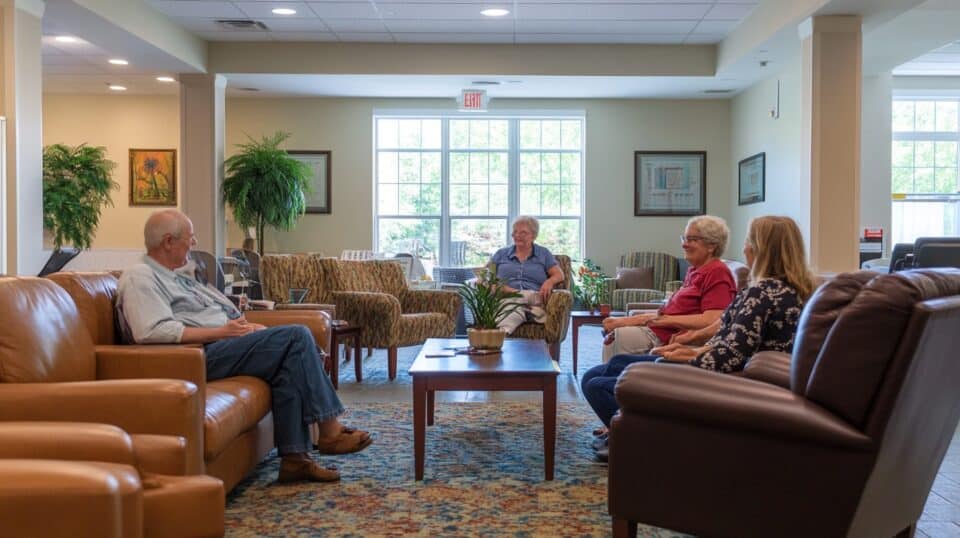Are you worried about paying for assisted living on a tight budget? You’re not alone. Many seniors face this challenge. The average monthly cost of assisted living is nearly $5,000. 1 But don’t panic! This article will show you six smart ways to afford assisted living on a low income.
Ready to learn some money-saving tricks?
Key Takeaways
Assisted living costs about $5,000 per month on average, but there are ways to make it more affordable.
Medicaid can help pay for assisted living in some states, covering care costs but not room and board.
Veterans may qualify for extra benefits like the VA Aid and Attendance program to help with assisted living expenses.
Converting a life insurance policy or using a reverse mortgage can provide funds for assisted living care.
Sharing a room or choosing a smaller living space can cut assisted living costs by 10-20% annually.
Table of Contents
Options for Low-Income Assisted Living

Money’s tight, but you’ve got options for affordable assisted living. Let’s explore some smart ways to make it work – from government programs to creative financial solutions.
Medicare and Medicaid Eligibility
Medicare and Medicaid can be lifesavers for seniors needing assisted living. But they’re not the same thing. Medicare helps with health costs, not room and board in assisted living. 2 You need a 3-day hospital stay first to get Medicare coverage for a nursing home. That’s important to know, ladies.
Medicaid is different. It can cover home health, nursing homes, and even hospice care. But here’s the thing – only about half of assisted living places take Medicaid. 1 Some states are better than others.
If you live somewhere with good Medicaid funding, you’re more likely to find a spot. It’s a good idea to check out your options. Next, let’s look at some housing programs that might help.
HUD Section 202 and 811 Programs
HUD’s Section 202 and 811 programs offer a lifeline for seniors and folks with disabilities. These programs help pay for housing that won’t break the bank. For Section 202, you only shell out about 30% of your income on rent.
It’s a sweet deal for older adults who are pinching pennies. The government chips in with interest-free loans to nonprofit groups. These groups then build homes that are comfy and affordable for seniors. 3
Section 811 works similarly but focuses on people with disabilities. It’s a game-changer for those who need a helping hand. The program ensures that very low-income households with at least one senior member (62 or older) have a roof over their heads.
Here’s the kicker – if the project serves these folks for 40 years, the loans don’t need to be paid back. That’s a win-win for everyone involved! 4
These programs are like a warm hug from Uncle Sam. They give our seniors and disabled friends a chance to live with dignity without worrying about sky-high rents, says Jane Doe, a housing advocate.
Now, let’s talk about how Medicaid can lend a hand with assisted living costs…
Public Support for Assisted Living Costs

Don’t let money worries stop you from getting the care you need. Uncle Sam’s got your back with some nifty programs to help foot the bill for assisted living.
Medicaid Waivers for Assisted Living
Medicaid waivers can be a lifesaver for women seeking assisted living on a tight budget. These waivers help cover care costs in participating facilities, but they don’t pay for room and board.
Here’s the scoop: Ohio’s Assisted Living Waiver Program is a great example. It foots the bill for care in approved homes. 6 Can’t find a Medicaid-approved spot? Don’t sweat it. Some states offer waivers for other communities too. 5
Let’s talk about Home and Community Based Service (HCBS) waivers. These gems support independent living and can be a game-changer. They’re like a helping hand that lets you stay in your community.
For dual-eligible folks – those who qualify for both Medicare and Medicaid – there’s even more good news. Some state plans or waivers can make assisted living more accessible. Next up, we’ll dive into Veterans Benefits for Assisted Living.
Veterans Benefits for Assisted Living
Veterans can tap into special benefits for assisted living. The VA Aid and Attendance program gives extra money to vets who need daily help. It’s on top of their regular pension. This cash boost can make a big difference in covering care costs. 7 Vets can also look into State Veterans Homes. These places offer skilled nursing care at lower rates than private facilities. 8
For vets who want to stay put, there’s good news too. The Veteran Directed Care Program lets them pick and manage their own home care services. It’s like being the boss of your own care team. 7 Another option is Medical Foster Homes. These are cozy spots where vets get round-the-clock care in a home-like setting. Plus, the VA can help pay for medical gear like wheelchairs or hospital beds.
These perks can really ease the load on a vet’s wallet.
Social Security Benefits
Social Security can be a lifeline for many women facing assisted living costs. It offers a monthly payment of at least $914 to those who qualify. This cash can help cover some of the expenses of care facilities.
But here’s the catch – living in assisted care might change how much you get. Some states chip in extra money on top of the federal amount. It’s like getting a bonus to help with your bills. 10
Social Security is not just a safety net; it’s a springboard to dignity in our golden years.
Don’t worry if this sounds tricky. Each state has its own rules about who can get this extra help. They look at things like how much money you have and where you live. The average extra payment is about $145 a month.
That might not sound like much, but every dollar counts when you’re on a tight budget. It’s smart to check what your state offers – you might be surprised at the help available. 9
Private Financial Solutions for Assisted Living

Money’s tight, but don’t lose hope! There are smart ways to pay for assisted living without breaking the bank. Let’s explore some private financial solutions that could be your ticket to comfortable care….
Life Insurance Conversions
Life insurance conversions can be a lifesaver for women facing assisted living costs. Here’s the deal: you can turn your policy into cash for care. It’s like swapping your old car for a new ride…
but with better perks. You’ll often get more money than if you just cashed out the policy. 11 Plus, the monthly payouts won’t interfere with your Medicaid eligibility. That’s a win-win!
But wait – there’s a catch. You need to really need long-term care right now to make this work. 12 And if your policy is on the smaller side, you might be better off keeping it or just taking the cash value.
It’s not a universal solution. Still, for many women, this strategy can be a game-changer for paying for assisted living. It’s worth looking into if you’re in a tight spot.
Reverse Mortgages & HELOCs
Reverse mortgages can be a lifeline for cash-strapped seniors. If you’re 62 or older and own your home, you might tap into its value without selling. Home Equity Conversion Mortgages (HECMs) are the most common type. 14 But watch out – the loan balance grows over time as interest piles up. 13
Home Equity Lines of Credit (HELOCs) offer another way to use your home’s value. Unlike reverse mortgages, you’ll make monthly payments. Both options require careful thought. Talk to a financial pro before diving in – it’s a must for HECMs.
Next, let’s look at how life insurance can help pay for assisted living.
Your home is your castle… and potentially your piggy bank.
Long-Term Care Insurance
Long-term care insurance can be a lifesaver for women planning their future. It kicks in when you can’t do two daily tasks on your own, like bathing or dressing. This coverage helps pay for services you might need as you age.
It’s not just for nursing homes – it can cover in-home care too. 16
Here’s the kicker: Medicaid pays for over half of all long-term care services in the U.S. But getting Medicaid isn’t always easy. Each state has different rules and payment rates. That’s why some folks are pushing for a federal benefit to even things out.
It could make getting care simpler for everyone. 15 Next up, let’s talk about how veterans can get help with assisted living costs.
Finding State and Local Assistance

State and local programs can be a lifesaver for seniors on a tight budget. These hidden gems often fly under the radar… but they’re worth digging for! Want to uncover more ways to stretch your dollar? Keep reading!
State Non-Medicaid Programs
Some states have special programs to help people pay for assisted living. These aren’t Medicaid, but they can still be a big help. For example, Alaska has a Senior Benefits program that gives cash to older adults with low incomes.
In Colorado, there’s an Adult Foster Care program that helps pay for care in small homes. These state programs aim to keep people out of nursing homes if possible. 17
It’s worth checking what your state offers. Each one is different, so you’ll need to look into it. Your local Area Agency on Aging can guide you in the right direction. They know all about these programs and can help you apply.
Don’t be shy about asking – that’s what they’re there for! Keep in mind, every little bit helps when you’re trying to afford assisted living on a tight budget. 18
Financial Assistance Locators
Financial help for assisted living can be tricky to find. But don’t worry! There’s a helpful tool called the Eldercare Financial Assistance Locator. It’s like a guide for money help, pointing you to over 400 programs.
Pretty cool, right? 19
Knowledge is power, especially for your finances.
I’ve used this tool myself, and it’s really useful. You just enter some info, and bam! It shows you options you might not have known about. It covers things like Medicaid waivers, veterans’ benefits, and even local programs.
Trust me, it’s worth checking out if you’re looking to save some money on assisted living costs. 20
Ways to Reduce Assisted Living Expenses

Cutting costs on assisted living doesn’t mean skimping on care. There are smart ways to save money… and still get great support. Want to know more? Keep reading!
Sharing Accommodations
Sharing a room can greatly reduce your assisted living costs. Imagine you and a friend splitting a two-bedroom apartment. You’ve just reduced your expenses by 10% to 20%. 21 That’s $4,000 to $8,000 saved each year – pretty good, right? Plus, you get someone to chat with over coffee or play cards with on quiet afternoons.
There’s more! If you’re comfortable with smaller spaces, a studio apartment could save you 15% to 20% on rent. It’s like finding extra money… every month. Don’t worry about feeling confined – many assisted living places offer excellent common areas where you can relax and socialize.
Consider: less space to clean, more money for enjoyable things like treating your grandkids or splurging on that fancy new hairdo. It’s beneficial for smart seniors looking to stretch their dollars further. Additionally, these savings could be particularly helpful for elderly drivers who may need to budget for transportation alternatives or vehicle modifications as their driving needs change.
Exploring Tax Credits and Deductions
Moving from shared living to tax breaks, there’s more good news. Uncle Sam might help with your assisted living costs. The IRS lets you deduct some medical expenses on your taxes. This includes long-term care for seniors who need help with daily tasks. 24
But hold your horses – not everything qualifies. Room and board, meals, and social activities don’t make the cut. To get the tax break, your medical bills must be over 7.5% of your income.
It’s tricky stuff, so chat with a tax pro. They’ll help you figure out what you can claim. Don’t forget about medical gear – that might be deductible too. Every penny counts when you’re trying to make assisted living work on a tight budget. 23
Seeking Community and Nonprofit Support
Community support can be a lifeline for seniors on a tight budget. Local charities often offer free meals, transportation, and even home repairs. Churches and synagogues may provide companionship or run errands for older folks.
Some nonprofits focus on helping seniors stay in their homes longer. They might install grab bars or ramps at no cost. These groups can be real money-savers!.
Don’t overlook your local Area Agency on Aging. They’re pros at finding help for older adults. They know about HUD programs that can cut housing costs. Plus, they can point you to other resources you might not know exist.
Next up, let’s talk about smart ways to plan for assisted living costs. 19 5
Financial Planning for Assisted Living

Planning ahead for assisted living can save you big bucks. It’s smart to crunch the numbers and shop around before you need care.
Developing a Financial Plan
Creating a financial plan for assisted living is key to a secure future. Here are some steps to help you build a solid strategy.
- Start early: Begin saving as soon as possible. Even small amounts add up over time. 26
- Calculate the numbers: Use a senior living cost calculator to get a clear picture of your expenses.
- List your assets: Make a detailed inventory of your savings, investments, and property. 25
- Monitor spending: Keep tabs on your daily, weekly, and monthly expenses to identify areas for potential savings.
- Consult an expert: A financial advisor can offer specific advice for your unique situation.
- Explore insurance options: Look into long-term care insurance to help cover future costs.
- Check benefit eligibility: See if you qualify for Medicaid or VA benefits to supplement your income.
- Budget wisely: Create a realistic budget that accounts for all your needs and some wants.
- Plan for the unexpected: Set aside an emergency fund for unforeseen expenses.
- Review regularly: Your financial plan can change. Revisit and adjust it as your needs change.
- Consider downsizing: Selling your home or extra belongings can free up cash for assisted living costs.
- Look into tax breaks: Some assisted living expenses may be tax-deductible. Check with a tax pro to see what applies to you. 25
Comparing Assisted Living Communities
Comparing assisted living communities is important when looking for affordable options. It’s like shopping for a new home – you want to find the best fit for your needs and budget. Here’s a breakdown of some key factors to consider:
| Factor | Why It Matters | Tips for Comparison |
|---|---|---|
| Cost | Monthly fees can vary widely | Ask for a detailed breakdown of all charges |
| Location | Proximity to family and amenities | Consider travel time for visitors |
| Services Offered | Affects quality of life and care | Make a list of must-haves vs. nice-to-haves |
| Staff-to-Resident Ratio | Impacts care quality | Higher ratios often mean better care |
| Community Size | Can affect social opportunities | Smaller communities might feel cozier |
| Medicaid Acceptance | Important for low-income seniors | Check if they have Medicaid beds available |
The average assisted living community has about 35 beds. 17 This info can help you gauge if a place feels too big or small. Also, keep in mind that costs have gone up lately. The median monthly price is now $4,300.That’s a lot of money!
Don’t hesitate to ask tough questions. How often do they raise rates? What’s included in the base price? Are there any move-in specials? 27 You’re not just picking a room – you’re choosing a home. Take your time, visit multiple places, and trust your gut. Your perfect fit is out there!
People Also Ask
How can I pay for assisted living if I’m short on cash?
Don’t fret! There are smart ways to foot the bill. You might tap into Social Security programs or look into Supplemental Security Income. Some folks use life insurance policies or explore long-term care insurance. Remember, every penny counts when you’re eyeing those care homes.
Does Medicare cover assisted living costs?
Sadly, Medicare doesn’t foot the whole bill. But don’t throw in the towel just yet! Medicare Advantage plans might chip in for some services. Also, check out the Program of All-Inclusive Care for the Elderly. It’s a mouthful, but it could be your golden ticket.
What’s this Aid and Attendance benefit I’ve heard about?
It’s a gem for veterans! If you’ve served our country and need help with daily tasks, this benefit could be your lifeline. It helps cover costs in assisted living residences. Just make sure you meet the service requirements. It’s like a thank-you note from Uncle Sam.
Can I use my home to pay for assisted living?
You bet! Your house might be your secret weapon. Look into home equity lines of credit or a reverse mortgage. Some folks even sell their homes. It’s like trading bricks for care. Just weigh your options carefully. Your home’s value could be your ticket to comfort.
Are there any government programs that can help?
Absolutely! The Housing Choice Voucher Program is worth a look. It’s like a helping hand from the government. Some states offer Medicaid waivers too. Don’t forget to check with your local public housing authority. They might have some tricks up their sleeve to help you out.
What if I have a life insurance policy?
That policy might be your golden goose! Look into life settlements or viatical settlements. It’s like cashing in your policy early. You could get a lump sum to cover your care costs. Just chat with your insurance company first. They’ll give you the lowdown on your options.
References
^ https://www.ncbi.nlm.nih.gov/pmc/articles/PMC10327408/
^ https://www.ncoa.org/article/does-medicaid-pay-for-assisted-living (2023-06-22)
^ https://www.hud.gov/program_offices/housing/mfh/progdesc/eld202
^ https://www.hud.gov/program_offices/housing/mfh/mfinfo/section202ptl (2023-10-11)
^ https://www.aplaceformom.com/caregiver-resources/articles/afford-assisted-living
^ https://ohio.gov/residents/resources/assisted-living-waiver-program (2024-05-20)
^ https://www.payingforseniorcare.com/veterans
^ https://www.va.gov/health-care/about-va-health-benefits/long-term-care/
^ https://www.payingforseniorcare.com/social-security
^ https://seniorservicesofamerica.com/blog/does-social-security-pay-for-assisted-living/
^ https://www.stmarkvillage.org/how-life-insurance-conversion-can-help-pay-for-ccrc-senior-living/
^ https://www.seniorstar.com/blog/how-to-pay-for-assisted-living-with-life-insurance-conversion/
^ https://www.aplaceformom.com/caregiver-resources/articles/reverse-mortgages-and-long-term-care (2023-10-12)
^ https://www.payingforseniorcare.com/financial-products/reverse-mortgages
^ https://www.ncbi.nlm.nih.gov/pmc/articles/PMC8695540/
^ https://www.ncoa.org/article/does-long-term-care-insurance-cover-assisted-living-a-comprehensive-guide (2023-09-22)
^ https://www.ncbi.nlm.nih.gov/pmc/articles/PMC8826534/
^ https://aging.maryland.gov/Pages/Senior-Assisted-Living-Subsidy-Program.aspx
^ https://www.payingforseniorcare.com/paying-for-assisted-living
^ https://www.payingforseniorcare.com/
^ https://www.payingforseniorcare.com/lower-the-cost-of-assisted-living
^ https://seniorht.com/pay-assisted-living/
^ https://www.aplaceformom.com/caregiver-resources/articles/assisted-living-tax-deductible (2024-02-20)
^ https://www.seniorlivingresidences.com/family-guide/financial-options/tax-deductibility/
^ https://encorecommunities.com/articles/financial-planning-for-assisted-living-understanding-costs-and-payment-options/
^ https://www.investgrape.com/post/senior-living-financial-planning-costs-benefits-strategies (2024-05-22)
^ https://seniorservicesofamerica.com/blog/how-to-pay-for-assisted-living-and-what-you-need-to-consider/



